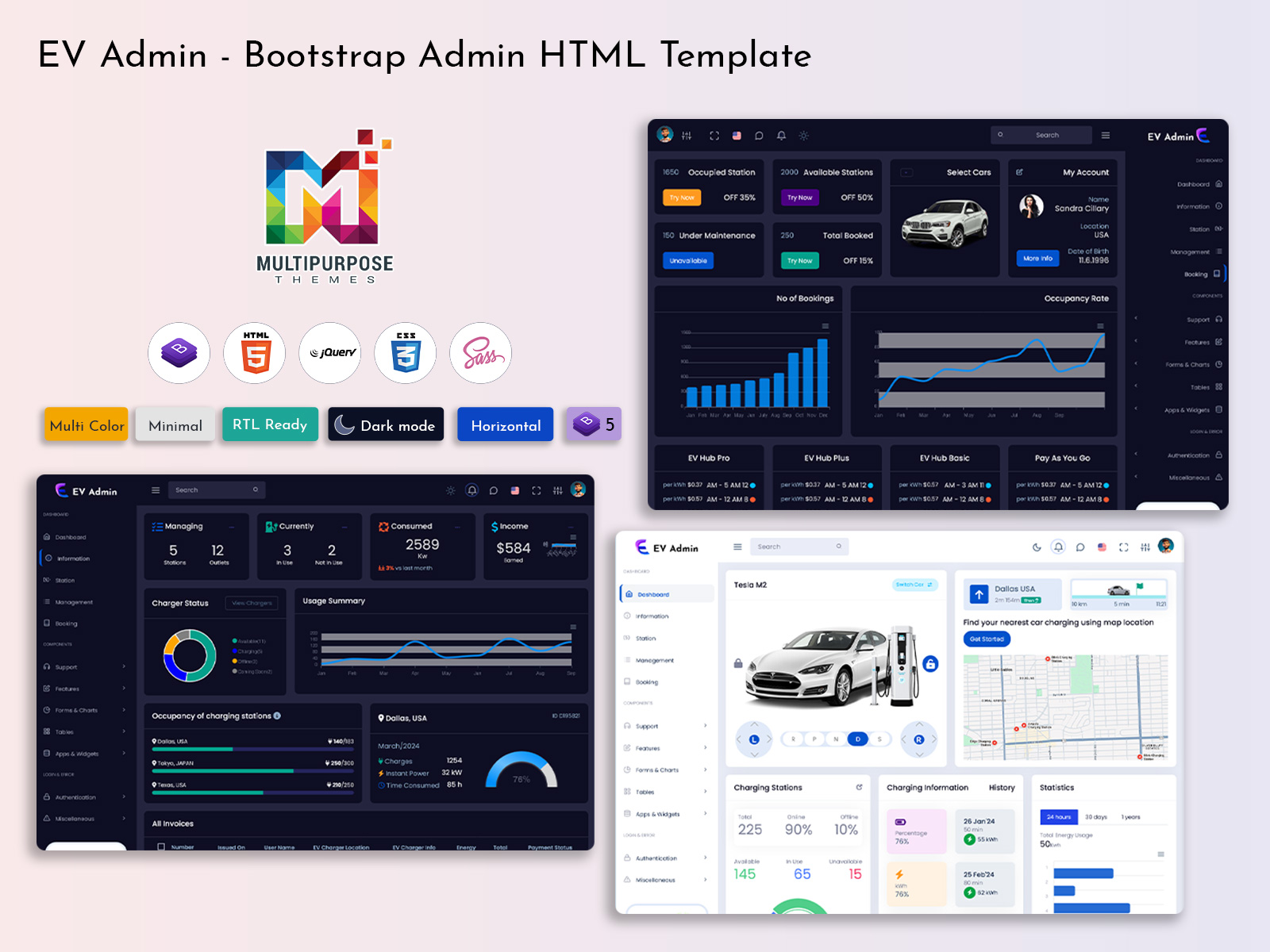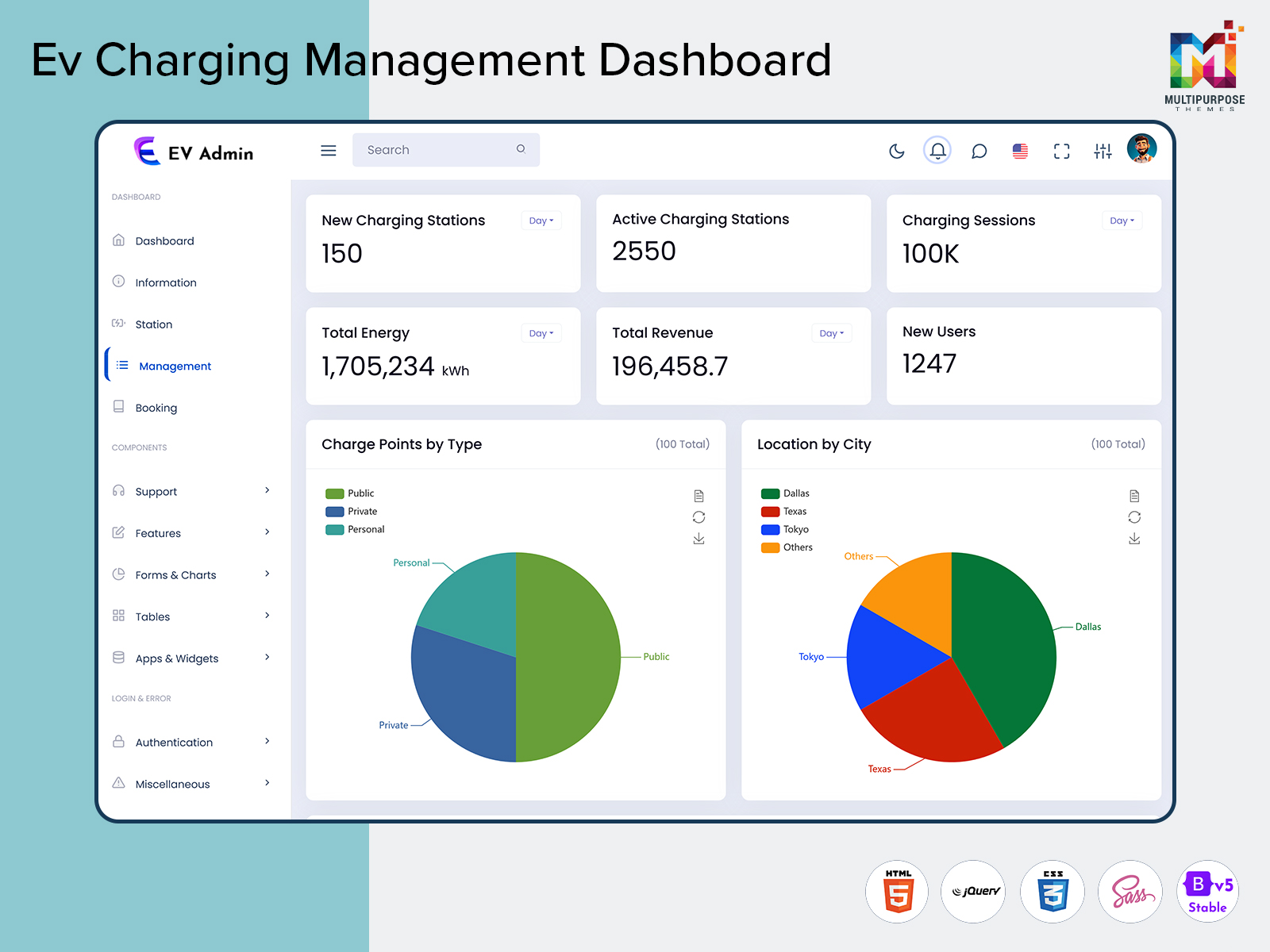Managing an EV charging station efficiently requires a modern and intelligent system. Our EV Charging…

EV Dashboard and Their Role in Smart Grid Transition
Reading Time: 7 minutes
The shift toward electric vehicles (EVs) and the integration of smart grid technology are two of the most significant trends in the energy and transportation sectors today. As EV adoption accelerates globally, there is a growing need to connect these vehicles to the energy infrastructure in smarter, more efficient ways. The role of the EV Dashboard in this transition cannot be overstated. It not only tracks vehicle data but also serves as a key enabler of communication between the vehicles and the grid, thus helping balance energy usage and enhance grid efficiency.
Dashboards of EV Admin
Vertical Dashboard – Dark
MORE INFO / BUY NOW DEMO
Pages of EV Admin
Information Page

MORE INFO / BUY NOW DEMO
Station Page

MORE INFO / BUY NOW DEMO
Management Page

MORE INFO / BUY NOW DEMO
Booking Page

MORE INFO / BUY NOW DEMO
Introduction: EV Dashboard
An EV Dashboard is a comprehensive tool that tracks and manages various aspects of electric vehicles, such as battery health, energy consumption, location, and charging status. It provides users with a centralized view of their EV’s performance and status in real time. With the evolution of smart grid technology, EV Dashboards are becoming increasingly integral to a decentralized energy system, where communication between vehicles, charging stations, and the grid is essential.
The primary function of these dashboards is to provide EV users—whether individuals or businesses—with accurate and timely data about their vehicles. But as the grid becomes smarter and more interconnected, these dashboards will also play a crucial role in connecting the Electric Vehicle Dashboard to larger energy systems, allowing for real-time communication and control.
Benefits of EV Dashboard
The EV Dashboard is designed to offer numerous benefits to users, operators, and energy providers alike. By consolidating all vehicle-related data into a single interface, these dashboards improve efficiency, enable proactive maintenance, and provide better energy management insights. Here are some of the key benefits:
1. Real-Time Monitoring
EV owners and fleet operators can track their vehicle’s charging status, energy usage, battery health, and location in real time. This is particularly useful for fleet managers who need to ensure that their vehicles are operational and charging efficiently, ensuring minimal downtime.
2. Optimization of Energy Consumption
As more EVs are integrated into the energy system, it is important to manage the consumption of electricity from the grid efficiently. EV Charging Dashboard enables fleet managers to monitor when to charge vehicles, how much energy is being used, and whether renewable energy sources, like solar power, are being utilized.
3. Enhanced User Experience
An intuitive and customizable Electric Vehicle Dashboard enhances the user experience by providing all the necessary data in one easy-to-read interface. Users can adjust charging schedules, track energy consumption trends, and receive alerts on charging status, improving both convenience and decision-making.
4. Integration with Smart Grid
The most critical advantage of EV Dashboards is their integration with smart grid technology. This allows vehicles to not only draw energy from the grid but also send energy back to the grid during times of high demand (Vehicle-to-Grid, or V2G). This interaction between the vehicle and the grid can help balance energy loads, reducing pressure on conventional power plants and making better use of renewable energy.
What is a Smart Grid, and How Are EVs Part of This Technology?
A smart grid is an advanced electrical grid that uses digital communication technology to detect and respond to changes in electricity usage. Unlike traditional grids, which deliver power only in one direction, smart grids allow for two-way communication, enabling utilities to manage energy use more efficiently. EVs are a critical part of this technology, serving as both consumers and suppliers of electricity.
Electric vehicles contribute to a decentralized energy grid. When integrated with smart grids, they can communicate with the grid to adjust charging times, optimize energy usage, and even return energy to the grid when necessary. This process, known as Vehicle-to-Grid (V2G) technology, allows EVs to act as energy storage devices, helping balance supply and demand.
Through the EV Charging Management Dashboard, users can track their vehicle’s energy usage and participation in V2G programs. This enables them to contribute to grid stability while also benefiting from financial incentives for supplying energy back to the grid.
EV Dashboards as a Critical Part of Smart Grid Communication
In the context of smart grid integration, EV Dashboard is indispensable. The EV Charging Management Dashboard acts as a communication hub between the electric vehicle, the grid, and the user. These dashboards allow for real-time data sharing between the vehicle and the grid, ensuring that energy usage is optimized. They also provide notifications when vehicles need to be charged or when it’s time to contribute energy back to the grid.
As EV Charging Management systems become more sophisticated, these dashboards will allow for greater control and customization. For instance, the EV Charging Dashboard can be used to manage energy distribution during peak hours, minimizing costs and supporting grid reliability.
For EV owners and fleet managers, this means they can easily schedule charging times, track energy consumption, and adjust charging speeds based on grid demand. As a result, the dashboard serves not only as a management tool but also as an integral part of the smart grid system.
Benefits of Vehicle-to-Grid (V2G) Technology in Balancing Energy Supply and Demand
Vehicle-to-Grid (V2G) technology is a revolutionary feature that allows electric vehicles to return energy to the grid. When many EVs are connected to the grid, they can serve as distributed energy storage systems, helping to balance electricity demand and supply. This is particularly useful during periods of peak energy demand when conventional power plants struggle to meet the demand.
The EV Charging Management Dashboard plays a central role in managing this interaction. By providing detailed data on battery status, charging schedules, and energy consumption, it allows EV owners to optimize when and how their vehicles participate in V2G programs. This contributes to a more stable and resilient grid, especially as renewable energy sources like wind and solar become more prevalent.
V2G technology can also generate revenue for EV owners by compensating them for providing electricity back to the grid. Through the EV Dashboard, users can monitor the amount of energy they have sent to the grid and track payments or incentives they receive for their participation in energy management programs.
Future Trends in EV Integration with Grid Systems
The future of EV integration with grid systems is filled with exciting possibilities. As more electric vehicles hit the road, the demand for efficient and integrated charging solutions will continue to grow. Here are some key trends to watch:
1. Widespread Adoption of Smart Charging Stations
The demand for Charging Station Dashboards will rise as more charging points are needed to accommodate the growing number of EVs. These dashboards will help operators monitor and manage multiple charging stations simultaneously, ensuring that each station is operational and serving users effectively.
2. Expansion of V2G Technology
In the future, we can expect V2G to become more mainstream, with an increasing number of EVs acting as mobile energy storage devices. This will be facilitated by advanced EV Charging Management Dashboards that offer real-time tracking of energy flows, optimizing when vehicles should charge or discharge based on grid needs.
3. Integration with Renewable Energy Sources
More charging stations will incorporate solar power through Solar Charging Dashboards, allowing EV owners to charge their vehicles using clean, renewable energy. As solar power becomes more integrated into the grid, Solar Charging Dashboard will play an important role in helping users track how much energy is being generated and consumed by their vehicles.
4. Intelligent Fleet Management
Fleet operators will increasingly rely on advanced Dashboard UI solutions for managing large numbers of vehicles. These dashboards will provide a holistic view of the fleet’s charging status, energy consumption, and overall performance, allowing managers to make data-driven decisions that improve operational efficiency.
Connecting EV Dashboard with Other Dashboards
Integrating EV Dashboards with other types of dashboards can enhance overall efficiency and streamline operations. Here’s how various dashboards interact with EV Dashboards:
– CRM Dashboard Template: By connecting the EV Dashboard to a CRM Dashboard, businesses can gain a better understanding of their customer’s EV usage patterns. They can send personalized messages or offers based on the data collected from the Electric Vehicle Dashboard, such as charging status or energy consumption trends.
– Medical Dashboard: In healthcare settings, hospitals and clinics with electric vehicle fleets can use the Medical Dashboard to track the status of their EVs, ensuring that emergency vehicles are always fully charged and ready for use. The integration of the EV Charging Dashboard with the Hospital Dashboard Template ensures seamless fleet management.
– LMS Dashboard (Your Learning App): With the growing focus on EVs and energy management, integrating an LMS Dashboard with EV Dashboards can offer employees training modules on energy efficiency, maintenance, and grid interaction. These systems can also track progress and provide real-time data on EV-related educational activities.
– HRM Dashboard: For organizations managing fleets of electric vehicles, integrating an HRM Dashboard with EV Dashboards enables better management of fleet-related perks and incentives. Employees who use EVs may be eligible for benefits such as free charging or rebates, and the HRM Dashboard can track and manage these incentives.
– Analytical Dashboard: Advanced Analytical Dashboards offer deep insights into energy consumption, charging patterns, and vehicle performance, helping fleet operators optimize their EV usage. These insights can be used to adjust charging schedules or identify areas for improvement in fleet efficiency.
– Warehouse Dashboard: For logistics companies, Warehouse Dashboards integrated with EV Dashboards can track the movement and charging of EVs, ensuring that vehicles are ready when needed. These dashboards can also help optimize charging stations within warehouses for more efficient fleet operations.
Why We Are Better?
Our EV Dashboard platform is superior because it offers seamless integration with a variety of other dashboards like CRM, HRM, LMS, Solar, and more. Our customizable Admin Dashboard UI provides fleet operators and businesses with all the data they need to manage their electric vehicles and energy usage. The Master Dashboard provides a holistic view of energy consumption, charging habits, and grid interaction, making it easier to make informed decisions that align with sustainability goals.
Buy Now – Conclusion
The future of energy is inextricably linked to the rise of electric vehicles and smart grid systems. With our comprehensive suite of EV Dashboard, businesses, fleet operators, and consumers can efficiently manage their EVs, optimize energy usage, and contribute to a more sustainable energy grid. Our dashboards, including the EV Charging Management Dashboard, Solar Charging Dashboard, and Admin Dashboard UI, are designed to offer real-time data, seamless integration, and unparalleled ease of use.
Don’t miss out on the opportunity to be part of the smart grid revolution. Buy now and take control of your electric vehicle fleet with our advanced dashboard solutions that make managing EVs, charging stations, and grid interaction easier than ever.
Buy Now and Get Started Today!
Click below to purchase and start unlocking the full potential of your business!
 skip to Main Content
skip to Main Content





This Post Has 0 Comments